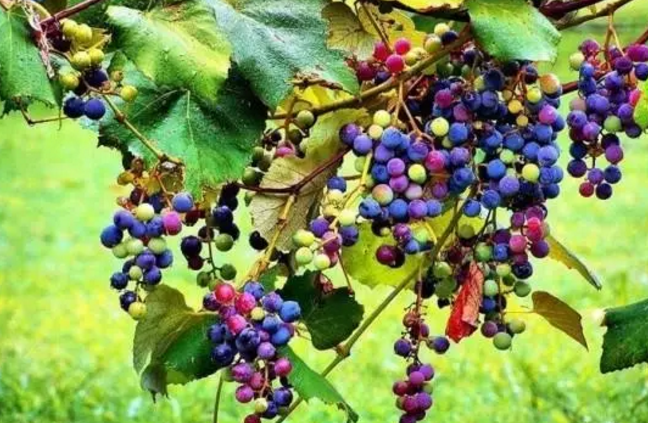The color of the grape fruit is one of the most intuitive sensory quality indicators for the identification of the grape. For the red and black grapes, the coloring area and the degree of coloration of the fruit are important factors for judging the maturity and quality, and also determining the selling price. Important factors of high and low.

First, face the grape hormone
Growth regulator. Plant hormones can control and change the growth process of plants, generally derived from plant endogenous hormones and exogenous hormones, but due to the small amount of endogenous hormones, and combined with weather, temperature and other factors, in large-scale agricultural production process Sometimes it can't meet the needs of crops and needs external supplements. However, we must face up to the use of plant growth regulators, which are now widely used in agricultural production. The target of plant hormones is plant cells, tissues and organs, so it is safe for humans! However, it should be noted that the use of hormones should pay attention to the correct method of use and concentration, otherwise it will produce adverse effects and cause economic losses.
Second, hormone promoting color change mechanism
Hormone changes. The grape fruit is turned from the expansion period to the hard core stage, and the green ripening period turns to the mature stage. The softening of the flesh, the discoloration of the peel, the conversion of the inclusions (sugar, acid), and the formation of the aromatic substances (fragrance) are observed. This process is regulated by a variety of endogenous hormones. Theoretical basis: the increase of abscisic acid and the decrease of auxin in grape fruit during the late development stage can stimulate the production of ethylene by the grape itself, thereby enhancing the activity of the alanine ammonia-lyase and the permeability of the cell membrane, and promoting the transport of sugar into the cell. It has a direct effect on the accumulation of anthocyanins and synthesis! Because the grapes have no peak of respiratory energy, the ethylene content in the mature period is reduced. At this time, supplementation of ethylene and abscisic acid can increase the respiratory intensity and promote color change.
Third, commonly used to promote color conversion hormone
Since the endogenous hormones of grape fruit play an important role in the growth and coloration of fruits, the use of plant hormones can regulate the level and balance of endogenous hormones to some extent. The plant growth regulators commonly used in the regulation of coloring and ripening are mainly ethephon, abscisic acid, phosphine, and carbazole.
1. Ethephon: the application of exogenous ethephon supplements in production can promote maturation, promote the accumulation of glucosides and promote coloration; in general, use ethephon 200m~500mg/L spray or dipped ear when coloring the fruit , can mature 4-11 days in advance; but need to pay attention to:
Time of use: Ethephon is very stable under acidic conditions. In general, grapes cannot release ethylene under acidic conditions. Therefore, the use of ethephon needs to be turned from yellow to yellow at the beginning of the color change of the grapes, and ethephon can be sprayed when the individual turns red.
Use concentration: If the concentration of ethephon is too high, it will cause adverse effects such as poor color change, fruit detachment, cracked fruit and old yellow leaves.
Remarks: Since ethephon promotes the formation of delamination, the use of ethephon alone causes the fruit to fall off and the grape ear is not resistant to storage and transportation. To reduce this side effect, 10 can be added when using ethephon. -20 mg / kg of indole acetic acid has a good effect of preventing fruit falling off.
2. Abscisic acid: consistent with the effect of ethephon, can promote the formation of anthocyanins, can also promote the ratio of sugar to acid, morning color, with the increase of abscisic acid concentration, the promotion effect is more obvious, but too high concentration will make the lower part The leaves turn yellow and fall off, which affects the accumulation of organic matter after harvest.
3. Regulating phosphine: Generally, in the first month before the ripening of grape berry, the whole plant sprays 250~500mg/L of phosphine, which can inhibit the nutrient growth of the grape, thereby promoting the content of soluble solids by 1-2 percentage points. It is colored and matured around the day; the mechanism of action of other hormonal substances is similar.
4. Remarks: Both ethephon and abscisic acid can promote the accumulation of glucoside, but it can not increase sugar, mainly because it increases the sugar/acid ratio of grape fruit, which reduces the acid content, not the solubility. Increase in substance (sugar content).
Fourth, matters needing attention
1. Different regions and different varieties have different concentrations. They need to be tested or applied locally, and then used in large areas.
2. Do not deliberately increase the concentration of the regulator for fast color change. With the above regulators, water and fertilizer management needs to keep up.
3. The use time must be started after the grape color change. It is used too early, the effect is not obvious, and it will easily lead to the occurrence of water tank disease.
Stevia Powder,Stevia Leaf Powder,Mint Stevia,Stevia Sugar
JINING USP INTERNATIONAL CO.,LTD. , https://www.uspintl.com